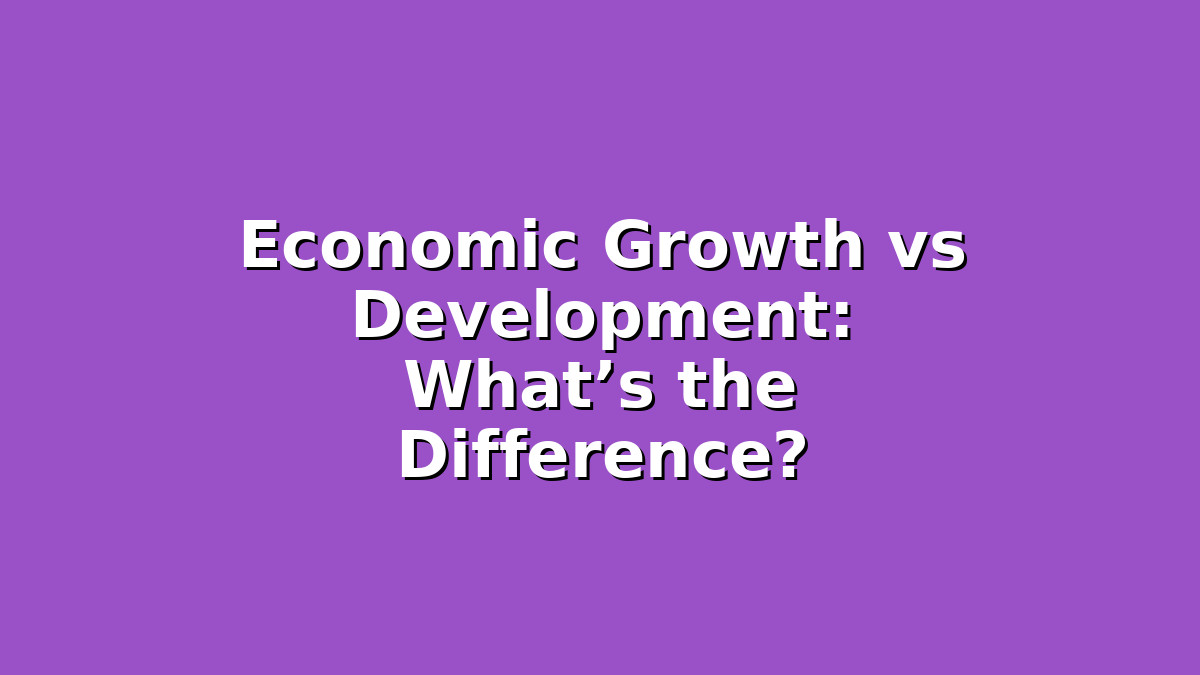When preparing for exams, especially in subjects like economics, geography, or social studies, it’s common to encounter terms that seem similar but have distinct meanings. Two such concepts are economic growth and economic development. Understanding the difference between these two is crucial not only for scoring well in exams but also for building a solid foundation in economic studies. In this article, we’ll explore what economic growth and development really mean, how they differ, and offer some helpful study tips to master these concepts effectively.
—
1. Understanding Economic Growth: The Numbers Behind Progress
Economic growth primarily refers to an increase in a country’s output of goods and services over time. This is often measured by the rise in Gross Domestic Product (GDP) or Gross National Product (GNP). In simple terms, if a country produces more goods or services this year than it did last year, it has experienced economic growth.
For students, it’s helpful to remember that economic growth focuses mainly on quantity—how much more is being produced. This could be due to factors like:
– Increased capital investment (more factories, machines)
– Improved technology
– A larger workforce
– Better education improving labor productivity
However, economic growth does not necessarily mean improvements in people’s quality of life or social well-being. This distinction is important to keep in mind when differentiating growth from development.
Study Tip: When revising economic growth, try to visualize it like a growing cake—bigger and more slices than before. Practice drawing graphs that show rising GDP over time. Also, quiz yourself on factors that contribute to economic growth and how it is measured. Flashcards with terms like GDP, GNP, and productivity can be very effective.
—
2. Exploring Economic Development: Quality Over Quantity
While economic growth measures the increase in production, economic development is a broader concept that looks at improvements in standards of living, poverty reduction, health, education, and overall well-being of people in a country.
Economic development includes:
– Higher literacy rates and better education systems
– Improved healthcare and life expectancy
– Reduced poverty and unemployment
– Better infrastructure and access to basic services like clean water and electricity
It considers both quantitative (how much is produced) and qualitative improvements (how those outputs translate into better lives). A country can have high economic growth but low economic development if the wealth isn’t distributed fairly or if social indicators remain poor.
Study Tip: To grasp economic development, try to connect theory with real-world examples. Read case studies of countries with rapid economic growth but limited development (e.g., some oil-rich nations). Use mind maps to link different aspects of development like health, education, and income distribution. Also, practice explaining these concepts in your own words—this will help retention and exam performance.
—
3. Key Differences and How to Remember Them for Exams
It’s easy to confuse economic growth and development, especially under exam pressure. Here are some core differences that you should keep in mind:
| Aspect | Economic Growth | Economic Development |
|———————|————————————|—————————————-|
| Definition | Increase in total output (GDP) | Improvement in quality of life |
| Measurement | Quantitative (GDP, GNP) | Quantitative + Qualitative indicators |
| Focus | Production and income levels | Health, education, poverty, equality |
| Impact | May not improve living standards | Aims to improve living standards |
| Timeframe | Short to medium term | Long term |
To remember these differences, a good mnemonic is: “Growth counts outputs; Development counts outcomes.” This can serve as a quick recall phrase during exams.
Study Tip: Practice writing short paragraphs comparing growth and development. Use past exam questions or create your own practice questions. To strengthen memory, explain these differences to a friend or study group — teaching others is one of the best ways to learn.
—
Conclusion: Mastering the Concepts and Excelling in Your Exams
Understanding the difference between economic growth and economic development is essential for students preparing for exams in economics or related subjects. While economic growth focuses on the increase in a country’s production and income, economic development covers a wider range of factors that improve people’s lives.
To excel in your exams:
– Use visual aids like graphs and mind maps to understand and remember concepts.
– Connect definitions to real-world examples and case studies.
– Regularly test yourself with flashcards and practice questions.
– Discuss and explain concepts with peers to reinforce your understanding.
Remember, economic growth and development are not just textbook terms—they are about how societies progress and improve over time. With consistent study and clear understanding, you’ll be able to confidently tackle these topics on your exams and beyond.
Good luck with your studies!
—

Responses